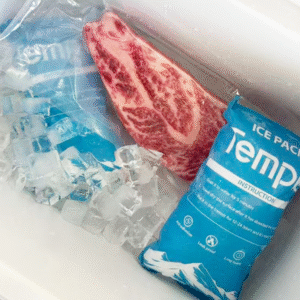How to Store Empty Dry Ice Bags Between Uses: Best Practices and Tips
Storing empty dry ice bags properly is essential for maintaining safety, امتثال, and efficiency in your cold chain operations. By following the best practices for ventilation, التحكم في درجة الحرارة, and proper storage techniques, you can extend the life of your bags and reduce the risk of contamination. This guide will walk you through the key steps to ensure your bags are ready for reuse, fully compliant, and safe for handling.

What Is the Best Way to Store Empty Dry Ice Bags?
Proper storage of empty dry ice bags is crucial to avoid safety hazards, such as CO₂ buildup, and to maintain the integrity of the bags for future use. The storage environment should be well-ventilated, رائع, and dry to ensure the bags stay intact and free from mold or damage. Storing the bags in a way that allows for gas venting and minimizes exposure to sunlight or heat can significantly extend their usability.
Key Storage Guidelines:
-
تهوية: Always store dry ice bags in a well-ventilated space to allow residual CO₂ to dissipate.
-
درجة حرارة: Keep the bags in a cool, dry area away from direct sunlight. Ideal storage temperatures range from 50°F to 85°F (10°C–29°C).
-
رُطُوبَة: Ensure bags are completely dry before storing to avoid mold growth and degradation.
-
ختم: Never seal bags around residual dry ice. This can lead to pressure buildup and potential ruptures.
Why Does Proper Storage of Empty Dry Ice Bags Matter?
اعتبارات السلامة:
Dry ice sublimates into CO₂ gas, which can accumulate if not allowed to vent. Storing dry ice bags in airtight containers poses a significant safety risk, as the trapped gas can cause pressure to build up, potentially leading to ruptures or explosions. By maintaining proper storage protocols, you can prevent hazardous situations and ensure safe handling of bags.
Cost Efficiency and Environmental Impact:
Reusing dry ice bags can help reduce packaging costs, minimize waste, and support sustainability goals. Proper storage extends the life of the bags, reducing the need to purchase new ones frequently and contributing to a greener cold chain process.
How Should You Store Empty Dry Ice Bags to Ensure Safety and Compliance?
1. Storage Environment and Container Types:
To avoid damage and ensure effective gas venting, always store dry ice bags in a ventilated container. Use materials such as polyethylene bins, حاويات الستايروفوم, أو insulated foam coolers with loose lids or vent holes. Avoid rigid, sealed boxes, as these can trap residual CO₂ and increase the risk of rupture.
| Storage Factor | Recommended Practice | What to Avoid |
|---|---|---|
| تهوية | Open containers, breathable lids | Airtight containers |
| العزل | Thick foam or insulated liners | Materials that crack under cold |
| درجة حرارة | تخزين في بارد, dry spaces (50°F–85°F) | Extreme heat or cold exposure |
2. Cleanliness and Moisture Control:
Ensure that dry ice bags are completely dry before storing. Any residual moisture can lead to mold growth or compromise the bag’s insulation. Consider using desiccant packets to absorb moisture, especially in humid environments. Regularly inspect bags for signs of condensation and ensure that storage areas are free from dirt, تراب, or pests.
How Do You Clean and Re-Stage Food-Contact Dry Ice Bags?
Step-by-Step Cleaning Process:
-
فحص الأضرار: Check for tears, الثقوب, or signs of wear. Retire any damaged bags from reuse.
-
Remove Residual Dry Ice: Always allow any residual dry ice to sublimate completely in a well-ventilated space.
-
Clean the Bags: Wash with warm water and mild soap to remove any visible debris. Avoid harsh chemicals that could damage the material.
-
Sanitize: استخدم EPA-registered food-contact sanitizer to ensure the bags are safe for reuse. Follow the manufacturer’s instructions for proper dwell time.
-
Dry Completely: Let the bags air dry completely before storing them. Avoid placing bags in direct sunlight to prevent UV damage.
What Are the Key Considerations for Storing Different Types of Dry Ice Bags?
Dry ice bags come in different materials, and the storage needs for each type can vary. على سبيل المثال, heavy-duty plastic bags are durable but sensitive to UV light, while nonwoven textile bags are more breathable but require careful drying to prevent mold.
| Bag Type | مادة | Storage Recommendations |
|---|---|---|
| Heavy-duty plastic | Polyethylene/foam | Store flat or lightly folded away from sunlight |
| Nonwoven textile | Synthetic fibers/foam | Air-dry completely and avoid compression |
| Foil-lined hybrid | Reflective foil/foam | Store flat, avoid sharp folds and rough surfaces |
2025 Trends in Dry Ice and Cold Chain Packaging
As the cold chain industry continues to evolve in 2025, there is a growing emphasis on sustainability and reusable packaging. ابتكارات مثل biodegradable dry ice bags, أجهزة الاستشعار الذكية embedded in packaging for temperature and gas monitoring, و desiccant-integrated liners are helping companies improve safety, تقليل النفايات, and enhance operational efficiency.
Key Trends to Watch:
-
Reusable Dry Ice Bags: The use of reusable packaging systems is on the rise, offering significant cost savings and sustainability benefits.
-
العبوة الذكية: Sensors in packaging allow for real-time monitoring of temperature and CO₂ pressure, ensuring the safe handling of products during transit.
-
Biodegradable Materials: Companies are exploring eco-friendly alternatives to traditional dry ice bag materials to reduce their environmental footprint.
التعليمات (الأسئلة المتداولة)
س 1: Is it safe to store empty dry ice bags in the freezer?
لا, it’s not safe. Freezers are confined spaces where CO₂ can accumulate, creating a potential safety hazard. Always use ventilated storage.
Q2: How often should I clean empty dry ice bags?
Clean bags after each use to prevent mold, odors, and contamination. A mild detergent and air drying are sufficient for most bags.
س 3: What should I do if a dry ice bag is damaged?
Retire any bags with visible tears or signs of wear. Damaged bags can compromise the integrity of your cold chain and pose safety risks.
الخلاصة والتوصيات
To store empty dry ice bags effectively, ensure that they are kept in a تهدأ جيدا, رائع, and dry بيئة. Follow a proper cleaning and inspection routine to maintain bag quality and safety. Consider the material of your bags and their specific storage requirements to maximize their lifespan. Regular inspections and proper storage can help reduce waste, improve cost efficiency, and ensure compliance with safety regulations.
الخطوات التالية:
-
Designate a storage area with adequate ventilation.
-
Implement a bag inspection and cleaning protocol for each use cycle.
-
Monitor storage conditions regularly to prevent moisture buildup and degradation.
حول Tempk
و Tempk, نحن متخصصون في حلول السلسلة الباردة, offering high-quality, reusable dry ice bags and packaging designed for safety, متانة, والامتثال. Our products help you maintain temperature integrity while reducing waste and operational costs. Reach out to us for expert guidance on optimizing your cold chain processes.























